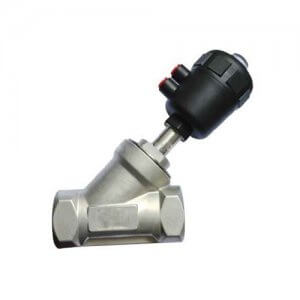Y Type Angle Valve is very ideal for On-Off pneumatic regulation of the media such as air, water, steam, Oil etc. These are accessible in screwed or flanged ends connections designed by our experts and are composed of the finest quality basic materials. It uses a linear motion to move a closure member into and out of a seating surface. Angle valves are commonly used in boiler feed water and heater drain service and in piping schemes where space is at a premium and the valve can also serve as an elbow.

Alluminium Oil Window
( Customer review)
Aluminium bodied sight level oil level indicators, also known as oil windows. Highly durable and corrosion resistant aluminium oil glass windows are often used in application where regular and accurate indication of the oil level is required.

Anti Spark PU Tube
( Customer review)
Combining outstanding spark resistance with superb flexibility, this range is perfectly suited for welding applications. Two types of PU - ether with PVC sheath or single layer ether. Is available and rapid installation with any type of Pneumatic Fitting.

Compact Cylinder SDA Series
( Customer review)
Pneumatic cylinder (sometimes known as air cylinders) is switch use the power of compressed gas to produce a force in a reciprocating linear motion.Like hydraulic cylinders, something forces a piston to move in the desired direction. The piston is a disc or cylinder, and the piston rod transfers the force it develops to the object to be moved. Engineers sometimes prefer to use pneumatics because they are quieter, cleaner, and do not require large amounts of space for fluid storage.Very compact design easy to use large companying force, easy in maintained

Compact ISO Cylinder
( Customer review)
Pneumatic cylinder (sometimes known as air cylinders) is switch use the power of compressed gas to produce a force in a reciprocating linear motion.Like hydraulic cylinders, something forces a piston to move in the desired direction. The piston is a disc or cylinder, and the piston rod transfers the force it develops to the object to be moved. Engineers sometimes prefer to use pneumatics because they are quieter, cleaner, and do not require large amounts of space for fluid storage.Very compact design easy to use large companying force, easy in maintained.

Diaphragm Operated Solenoid Valve
( Customer review)
Diaphragm valves are bi-directional, on-off throttle valves. They are used to control fluid flow by regulating the area with which media can enter and exit the valve, effectively changing its speed and velocity.The most common diaphragm valves use pneumatic actuators; in this type of valve, air pressure is applied through a pilot valve into the actuator which in turn raises the diaphragm and opens the valve. This type of valve is one of the more common valves used in operations where valve speed is a necessity.AVAILABLE IN BRASS, STAINLESS STEEL, HIGH PRESURE APPLICATION

Double Acting Tie Rod Cylinder
( Customer review)
Pneumatic cylinder (sometimes known as air cylinders) is switch use the power of compressed gas to produce a force in a reciprocating linear motion.Like hydraulic cylinders, something forces a piston to move in the desired direction. The piston is a disc or cylinder, and the piston rod transfers the force it develops to the object to be moved. Engineers sometimes prefer to use pneumatics because they are quieter, cleaner, and do not require large amounts of space for fluid storage.It comes with our own standard. Robust in construction tie rod design.

FRL Unit
( Customer review)
FRL UNIT is basically combination of Air filter, Air regulator an Air lubricator.

Manually Operated Direction Control Valve
( Customer review)
In the absence of electrical supply, manually operated valves such as Hand Lever Valves are used. The functioning is the same; however, the solenoid coil is replaced by a hand lever, which controls the movement of the spool inside the valve, thereby allowing the air to pass.

Mechanical And Manual Panel Maounting Valve
( Customer review)
In the absence of electrical supply, manually operated valves such as Hand Lever Valves are used. The functioning is the same; however, the solenoid coil is replaced by a hand lever, which controls the movement of the spool inside the valve, thereby allowing the air to pass.



